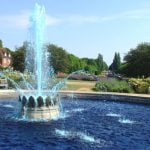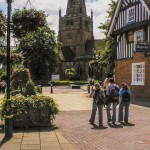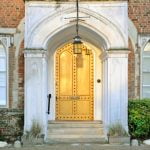Sheffield is a city filled with architectural wonders; but outside of the concrete and stone lies a green area, filled with trees, parks, wild fields, and unforgettable views. When people visit big cities, they sometimes forget what lies underneath the surface of the buildings that have been erected over the past few hundred years. One such place is Endcliffe Park, one of the most beloved parks in the Sheffield area. Adored for its sweeping waterfalls, stepping-stone-filled streams, and open spaces; this park is certainly a place of nature.
In this piece, we’re certainly going to highlight some of the more natural areas of the beautiful city of Sheffield – while also pointing out great places to shop and eat, of course! So, sit tight, hold on to your hat, and scroll through our five-minute guide to Sheffield.
History of Sheffield!
Sheffield name comes from the River Sheaf. It was founded in the early 12th century by the local lord of the manor, William de Lovetot, who then built a castle on today’s Castle Market site. Unfortunately, the castle was burned down in Sheffield castle but it 1266, but it was soon rebuilt to its glory in 1270; just four years later. Following the rebuilding of the castle, William de Lovetot also decided to have a church built; which stood where Sheffield’s Cathedral stands today. A small town slowly developed in the boundaries that lay between the castle and the church; which was something that happened often during that time period.
Wool was the main item of trade in Medieval Sheffield, with the wool being fulled and dyed in the same town. At the very end of the 13th century, in 1297, Sheffield’s people were given the right to hold a market each week, as well as a yearly fair. These markets and fairs brought an increasing amount of trade to the town each year, with people from all of South Yorkshire coming to attend and buy or sell goods.
The 14th century saw Sheffield become infamous for its cutlery. The King at the time even owned a knife from Sheffield, which was recorded as a part of his possessions in the Tower of London. There were other towns known for their prowess in cutlery creation, of course, but Sheffield was an important one.
Despite the soaring cutlery trade in the area, there was a lot of poverty in 17th century Sheffield; about a third of the population needed the help of their neighbours to survive day-to-day. The civil war of 1642 did nothing to help matters, with Sheffield castle being taken and then later destroyed to prevent it from being taken again in 1648.
The 18th century saw the construction of an all-boys charity school, almshouses, a theatre, and an infirmary. Industries rapidly grew, with iron being at the forefront, as well as new developments in steel, copper, and silver being made. In fact, in 1773, Sheffield was given its own silver assay office.
In 1836, Sheffield’s Botanical Gardens were opened. At first, they were just privately owned but the council soon purchased them back in 1898. The Glass House of the gardens is a favourite of many visitors today, as well as the elegant floral displays. The old Victorian hothouses have been restored, too.
Sheffield was made a city in 1893, with its Town Hall being built just four years later in 1897. Life in Sheffield started to improve once the council took over the water supply, built sewers and drains, and built a sewage treatment plant. At the very end of the 19th century, the first electric trams of the city started to run in its streets. In 1921, the boundaries of the city were extended to include the areas of Handsworth and Wadsley; and again in 1935, they were changed to include Totley, Dore, Beauchief and Greenhill, too.
Sheffield University was founded in 1905, bringing more people to Sheffield in search of education. Though the more traditional industries of the city declined when the 20th century came about, Sheffield built more forms of transport (including their supertram and an airport), and tourism lit the city back up.
From the opening of the National Ice Centre in 2003 to the development of the Millennium Square in 2006, Sheffield has really lent into the tourism industry. Today, the population is somewhere over 700,000! A far cry from the couple of hundred people living there in the 12th century.
What to do in Sheffield!
When we say there’s plenty to do in Sheffield, we mean it. From local food that you can grab on the go, to vibrant cinemas with more to offer than a simple sit-in movie. Sheffield is even home to the tallest University building in the UK; and yes, you can get to the top for some incredible views. We’re speaking of The Arts Tower, which has a paternoster lift that constantly moves. Hop on, ride to the top, and catch another lift back down when you’re ready to leave. The building was constructed on top of a hill, too, which just adds to the height and the experience.
But we’re sure that none of our readers is going to spend the day hopping on and off lifts that don’t stop, so here’s a few other options:
Shopping
The independent spirit of Sheffield can be seen in every retail store on every street. The city has quite a few different clusters of shops and markets, as well as a huge indoor shopping centre by the name of Meadowhall.
Fargate and The Moor offer a whole host of big retail names, and between them, they form two of many district-like areas in Sheffield that are just full of places to shop until you drop. But Meadowhall is the biggest shopping centre in Yorkshire, so we recommend visiting it; especially if it’s raining during your trip.
The Antiques Quarter piques the interest of many tourists and locals. It’s just full of temping places to go, from tea rooms to genuine retro shops. There are over 60 shops in the Antiques Quarter area, as well as the city’s oldest cinema: Abbeydale Picture House. You can also find Pedlar’s Corner Carboot and Flea Market in this section of Sheffield; a perfect place for finding bargains. A vintage market takes place three times a year, too.
Devonshire Quarter is quite the opposite of the Antiques Quarter. Rather than being full of the old and the quirky, this part of the city is quite cosmopolitan and modern. You can find fashion boutiques, independently owned music stores, and a whole bunch of unique shops run by entrepreneurs.
Food and Drink
We’ve mentioned that there are a few tea rooms in the Antiques Quarter, so here’s one of our favourite businesses: Jameson’s Café & Tea Rooms. With a team room that has 80 seats, its own pianist who plays during lunchtime, and an adjoining antique shop, Jameson’s certainly brings a different vibe to the usual atmosphere that surrounds afternoon tea. The shop is open from late morning to late afternoon each day and can be found on Abbeydale Road.
If you’re in the city centre and after a quick bite, The Lucky Fox has exactly what you need. They offer coffee, sandwiches, cold beers, and even fried chicken. Their waffles are delicious, and their service is top-notch! Find them on Division Street, just a mile away from Sheffield’s train station.
Next, let us introduce you to Make No Bones; a vegan restaurant with generous portions and unbelievable prices. Located on Rutland Way, they’re open every day except Monday (and who likes Mondays, anyway?).
And for authenticity, go no further than Piccolos. This family-run restaurant has been serving food to their guests since 1998, and it’s located in the very heart of Sheffield on West Street. Set over two floors with more than enough tables for you to come along and try their Italian cuisine.
Music and Entertainment
Sheffield is the birthplace of bands such as Bring Me The Horizon and the Arctic Monkeys, among many others. The music scene is alive and thriving, and it’s definitely one of the UK’s leading music and entertainment cities.
There are so many music venues here that it’s almost guaranteed that you can find somewhere to go with music you like playing all night long. Sheffield Arena and the O2 Academy often welcome special musicians and tour dates, while The Leadmill is the longest-running independent music venue in the city. Pop by for an unforgettable club night!
Every summer, the Tramlines festival also comes to visit. Next year, in 2020, it’s taking place in Hillsborough Park from the 31st of July to the 2nd of August. Tickets are already on sale and you can split your payment up to pay monthly if you want to. 2019’s summer line-up saw big names like Annie Mac and Two Door Cinema Club.
As for entertainment that isn’t music-related, why not visit one of Sheffield’s theatres or cinemas? Or even head over to the Tropical Butterfly House for an experience you’ve never had before? Sheffield is full of things to do. There is an artist atmosphere to the city, and it’s not all down to the many street artists that live there.
Travelling in Sheffield!
The Supertram network definitely makes getting around Sheffield a lot faster than it used to be. You can board any tram or local bus with every corner of the city within your reach. All trams are accessible and there are tonnes of stopping points in the city. Run by Stagecoach, the company has been assisting the travellers of Sheffield since 1994, and they pride themselves on a reliable service.
You can plan your journey online, and there are several tram and bus routes that will suit your needs. As for tickets, prices start from just £1.90 for a short journey. A tram & bus ticket will set you back £4.60 for an adult, but you can also buy evening-only tickets which are a bit cheaper. There’s an app, and most services now accept contactless payments.
Sheffield is also home to a major train station that has routes running across the UK, including those that come and go from London and other large cities.
Places to stay in Sheffield!
There are over 100 various types of accommodation in and around the city of Sheffield (not counting AirBnBs). In the city centre alone, there are approximately 50 places to stay. Near the train station, you can find Hotel Novotel for £65 a night, Jurys Inn for £53 a night, and Best Western for £45 a night. And those are just three of the closest hotels!
One of the most favoured hotels is the Leopold Hotel with over 500 reviews on Google; those average at a 4.4-star rating for this 4-star hotel. You can find this beautiful 19th-century building on Leopold Street, with its contemporary style and upmarket facilities.
As for AirBnBs, there are many. There are places available from just £16 a night, as well as an Edwardian Villa, private rooms, lodges, and modern apartments.





